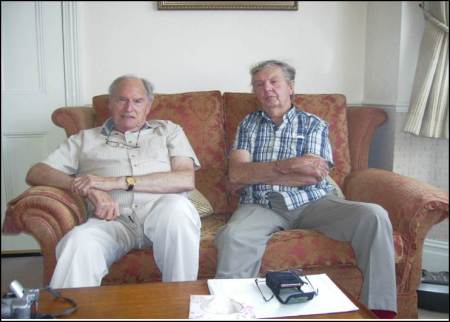
Two wartime friends reunited again after nearly 75 years, 2014 – evacuee Peter Pollard (left) and Derek Witney, Chessington Zoo staff child (right) Photograph: Derek Witney
A chance conversation with the Hart family about their ‘zoo evacuee father / grandfather’ whilst picking crops in our wartime garden as part of our Junior Keeper experience back in 2008 led me to the story of Peter Pollard, Derek Witney – and the tragic story of Chessington Zoo on 2nd October 1940.
These are some of the previously unpublished memories I have been sent by Peter and his sister Wendy, along with the story of Derek Witney, wartime Chessington and Paignton Zoo staff child.
Ladies first …
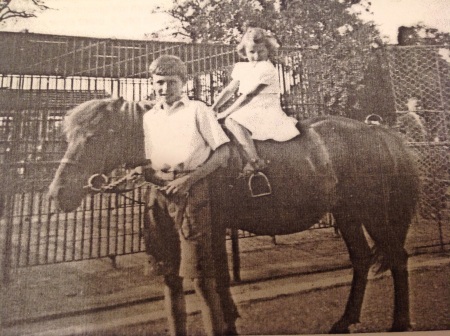
Peter and Wendy Pollard, Chessington Zoo 1940 (Pollard family album)
Wendy Gothard (nee Pollard): 1940 Chessington memory
“As I was only four when we lived at Chessington Zoo in the Summer of 1940, my memories could best be described as snapshots, but they are very clear. I was allowed complete freedom to play around the zoo all day long, without any adult supervision, and apart from scraped knees I came to no harm.
I loved the rehearsals for the circus. I would sit on the bench closest to the ring, all on my own – magic. Sometimes there would be cubs born to the big cats, and I shall never forget sitting on the ground and having a cub carefully settled on my lap for a cuddle.
The slides in the playground both thrilled me and scared me to bits. They were very high, and of course even taller for a small person. The older children would go down head first, but I never managed that.
Our caravan in the corner of the field was amazingly quite small. With gas mantle lighting the temperature ranged from ninety odd degrees near the ceiling to freezing at floor level. My mother would stand ironing in her bra and sheepskin boots. In the floor there was a small trapdoor which my parents would open for ventilation until an air raid warden came knocking saying he could see the light from a long way off. With several windows it was difficult not to have a single chink of light showing.
I remember well the night of the bombing when the big air raid shelter was hit.
The small brick shelter is clear in my mind, but I have no picture of the big shelter. The next day I was forbidden to go the zoo, and I knew something terrible had happened there, so perhaps my mind blotted it out.
Later my mother told me that the bomb rolled down the steps, but they did not tell me that my playmate [Derek Witney],* the son of the zoo manager, was among those killed.
We did not know whether the Germans had just unloaded a few bombs on something suspicious or were actually aiming for a munitions factory just up the road, but my father was in a great hurry to move us away from the zoo in case they returned.
However, one of the bombs had made a crater in the lane from the zoo to the main road, and he had a big problem getting the caravan out. The animals were evacuated to [Whipsnade].* They were taken away two by two , an unusual sight as the elephants plodded along the main road.
My time at the zoo is among my most cherished memories. It was my garden, my playground ,and even when the visitors were there, it was still my zoo. Fortunately, they went home.”
Wendy Gothard (nee Pollard), Chichester, December 2008.

Wendy Pollard and Derek Witney, Chessington Zoo 1940 (Pollard family archive)
Researching this story, I struggled to reconcile this memory with any WW2 casualty lists, but as it later proved it was not Derek Witney who was killed on the night but another of her zoo playmates. Derek Witney thinks the elephants were headed somewhere else- Devon!

Aerial detail of Chessington Zoo from Alan Ashby’s We Went to the Zoo Today: The Golden Age of Zoo Postcards (2009)
Chessington Memory – Peter Pollard (born 1930)
By the end of August 1939 I was approaching my ninth birthday, my sister Wendy was five years younger and we lived with our parents in a three year old detached house by the River Thames at Richmond. However when war was declared I was not actually there, having been sent for safety to The Linns, a 1000 acre dairy farm outside Dumfries, owned by my Uncle Alex and Aunt Kathleen. It was in a window seat at The Linns on 3rd September 1939 that I listened to the historic broadcast by Neville Chamberlain which ended “and I have to tell you now that no such undertaking (to withdraw from Poland) has been received and that consequently this country is at war with Germany” …
The rest of the family were not cowering from the bombs in the bolt hole under the stairs. My father let the house for the duration of the war to a Czech diplomat called Pospisil, bought a small caravan and sited it in the car park at Chessington Zoo which I think was still open but very quiet. Later on a bomb did land on Richmond Palace across the river and the blast damaged our house, but fortunately it was empty at the time.

My rough sketch notes from my conversation with Derek Witney on 1940s locations, identified with Derek on a more recent 1960s 1970s map of Chessington Zoo from the online Chessington Zoo.info website
Chessington Zoo – 1939/40 memory by Peter Pollard
In 1939 the zoo proper occupied the same area as it does now, although the animals and attractions were very different. There was one small field for parking on the North Boundary, whereas now there is parking for thousands of cars at both North and South ends. At the heart of the Zoo was “The Burnt Stub”, a beautiful old manor house occupied by the owner Reginald Goddard.
The Southeast quadrant of the site was mainly a vast playground of high slides, oscillating roundabouts and swing boats.
In the centre of the site, and immediately in front (i.e. South) of “The Burnt Stub” was a small permanent circus with stabling and props rooms, and also the terminus and workshops for the miniature railway. This was no land train but a genuine miniature locomotive, all steam and polished brass, which took visitors around the site on narrow gauge tracks.
Just to the west of the Burnt Stub was an odd construction, a cafeteria room with large cage attached to the left and right hand sides for lions and tigers respectively, while beyond that was a small lake for water birds like flamingos.
I returned from [school at Dumfries Academy in] Scotland in the Spring of 1940, and had free access to all parts of the zoo, even the private areas. This was quite perfect for a boy of nine. I helped to feed all the wild animals, and the ponies in the circus. I helped backstage in the circus during the performances, hosed down the elephants, helped to polish and maintain the rolling stock and rode the rails whenever I wanted., and spent hours in the huge playground.
But it didn’t last.
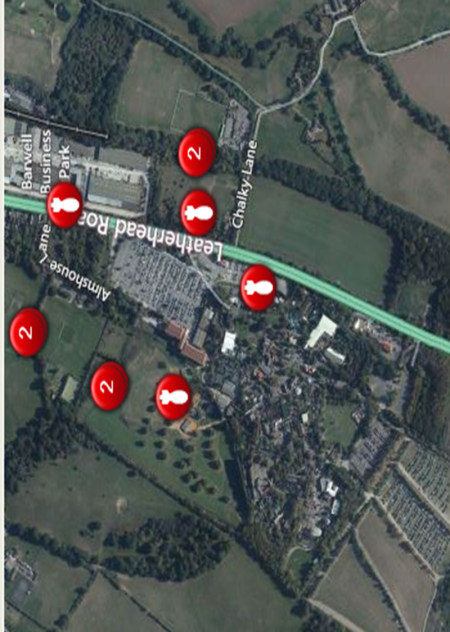
Satellite mapping of Chessington Zoo Bombsight.org 1940/41 bomb mapping
The Chessington Raid – memory by Peter Pollard
There were two air raid shelters in the zoo.
The first was a small brick surface shelter like a tool store, with room for four camp beds, which was used by Mr. Goddard and his family. It was not blast resistant.
The second was a proper shelter, excavated four feet into the ground and covered over with arched corrugated sheeting and the excavated earth to five feet above ground. There was enough room for about twenty people, sleeping on wooden shelves. This was where my family and I spent our nights, sharing with the zoo keepers and their families. It was by uncomfortable, with no privacy and little sanitation.
One day in the summer of 1940 Mr Goddard who owned a second zoo in Paignton [* Goddard had entered a wartime business arrangement with Herbert Whitley at Paignton Zoo] to which he had transferred some animals, told my father that he would be making a short inspection visit to Devon, and invited my family to use his shelter while he was away.
That same night a German Bomber flew over and mistaking the zoo buildings for a nearby army camp in the moonlight, dropped four bombs.
The first breached the railings of the water bird enclosure, releasing dazed birds to wander round the Zoo.
The second blew out the cafeteria, leaving the big cats on either side uninjured and angry but fortunately still secure.
The third landed on the driveway and did little damage but the fourth penetrated straight through the roof of the big shelter, exploded and killed every body inside, including our friend ‘Derek Witney’.* [Here Peter has made a fortunate memory slip after 70 years]
Our family in the flimsy brick shelter was unscathed, and I didn’t even wake up.
Chessington wartime memory by Peter Pollard.

Bombsight.org 1940 /41 bomb map of Chessington Zoo with one bomb clearly on the zoo site. Image : bombsight.org
The aftermath – a memory by Peter Pollard
My father decided that we were still too close to the Luftwaffe bombing campaign on London and hastily removed us to a farm at Christmas Common in Oxfordshire where we had only well water and a two mile walk each way back to the shops in Watlington.
This was a bit too primitive, and we came back as far as a farm at Hedgerley, between Beaconsfield and Slough. The farm was owned by the Halse family and it was Brenda Halse who taught me how to trap and skin rabbits. It was still a two mile walk each way to the good shops in Beaconsfield but at least it was sometimes (depending on the weather) possible to get a bus into Farnham Common where I attended a small primary school for the Autumn term of 1940.
In January 1941 I was sent off to Board at Derby Grammar School, which was settled in a holiday camp in the wilds of Derbyshire near Matlock. But that is another story …
Previously unpublished Chessington wartime memory by Peter and Wendy Pollard, written up for the World War Zoo Gardens project November 2008 (with thanks to the Hart family).

The dustjacket cover to Frank Foster’s circus autobiography Pink Coats, Spangles and Sawdust (Stanley Paul, late 1940s) Image: Mark Norris, private collection
Frank Foster’s account
Frank Foster, “Pink Coat, Spangles and Sawdust”, published by Stanley Paul 1949?
Frank Foster was a circus performer, ringmaster and equestrian director who wrote one of the few accounts of wartime Chessington Zoo. R.S. Goddard (or ‘RSG ‘ as Derek Witney still calls him) died very suddenly at Christmas 1946 and few archive records have survived throughout the changing ownership of Chessington Zoo.
P.158. “After we had arrived back at Chessington twenty-one bombs fell in the grounds. One was a direct hit on a shelter and killed three attendants.
Two high explosive bombs dropped within a hundred yards of the elephants quarters. With lions, tigers, polar bears and many other animals to look after, this was an anxious time.
Apart from the possibility of their being killed there was the danger that cages might be blasted open and occupants escape into the surrounding countryside.
Fortunately this has only happened to the penguins’ cage: their quarters were completely demolished.
Searching in the debris for their remains, we were astonished to see them walking towards us, like Charlie Chaplins, along the miniature railway track.
They’d been blown clear and without hurt. Later came the buzz bombs …”
These blitzed penguins are possibly some of the ‘dazed water birds’ that Peter Pollard mentioned. (Derek Witney chatting in October 2015 also thinks this might be a bit of characteristic circus story embroidery by Goddard or Foster).
Frank Foster’s 1949 book is out of print and hard to obtain, so I have scanned the 4 relevant pages about wartime:

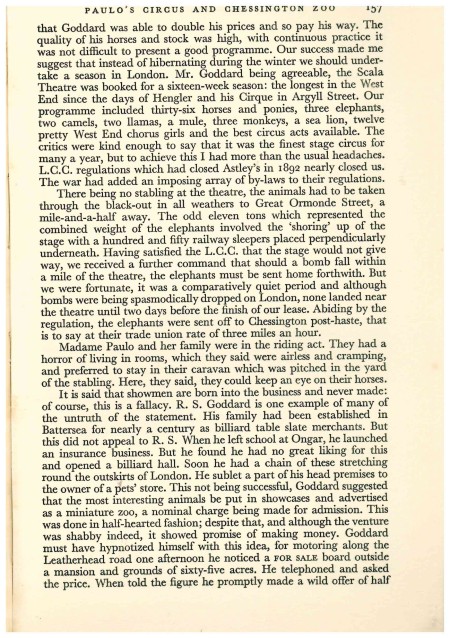


Tracing the Chessington Zoo Casualties of 2 October 1940
For a while I could find no trace of a Derek Whitney being killed at Chessington Zoo or a bombing date. Now thanks to the CWGC records being online, I have found the identity of the child and other zoo staff sadly killed that day.

The three casualties recorded CWGC as “Died at Chessington Zoo Shelter” on 2nd October 1940 by the Municipal Borough of Surbiton are:
- Annie Page, aged 37, the Cottage, Zoo, Chessington. Daughter of Mrs Todd, 128 Woodside Road, Westborough, Guildford, wife of Reginald Page.

2. Ronald Page, aged 10, son of Reginald and Annie Page.
3. Elizabeth Arnold, aged 54, of the Lodge, Chessington Zoo, wife of George Arnold.
Several family photos of the Page family, Ronald, Reginald and Annie can be found on the Ancestry website.
A BBC audio clip of Peter Pollard 2010
There is a short sound clip of Peter from 2010 online talking about the bombing on a BBC Radio Cornwall report as well as a brief paragraph:
“For a while Peter Pollard found himself living in a caravan in the car park of Chessington Zoo at the age of nine in the summer of 1940. He shared his memories with the Zoo for the exhibition.
Reflecting on the time Peter said: “It was wonderful for a small boy of nine. I had a complete run of the zoo, I helped in the circus, maintained a miniature railway, they had an enormous playground there, it was perfect, it was heaven.”
http://news.bbc.co.uk/local/cornwall/hi/people_and_places/history/newsid_8539000/8539314.stm
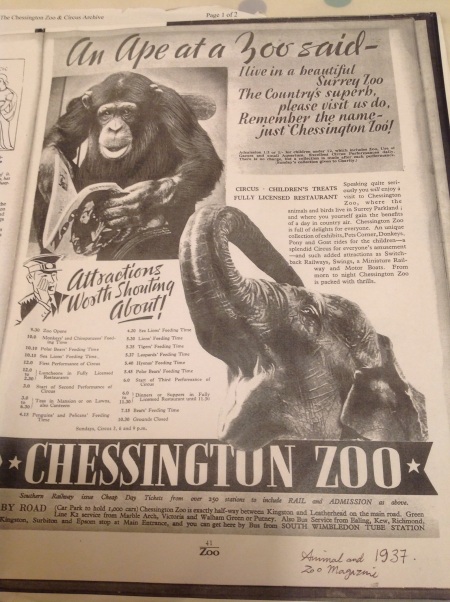
Chessington Zoo advert 1937, Zoo and Animal Magazine (Image source: Mark Norris private collection)
Researching and confirming this wartime story
Curiously the Pollard’s 9 & 5 year old memories seem to suggest that they quickly left Chessington for safety somewhere else and were told their playmate ‘Derek Whitney‘ [sp] was killed in the bombing.
What they did not know until 70 years later was that Derek had left that day with his father, the park’s engineer, to take some animals and the miniature railway down to Paignton Zoo, a story Derek confirmed when he visited me at Newquay Zoo last year. Leopards, lions and tigers were mentioned as travelling down. Mr. Witney was there on behalf of Chessington Zoo’s Mr. Goddard to help Mr. Herbert Whitley open his zoo up again (see late August 1940 press cuttings) from its early wartime closed state.
The Miniature Railway by the way is still going strong at Paignton Zoo. Mr Witney, Derek’s father, was the Chessington Zoo Engineer and organised taking one train and the track down to Paignton Zoo. According to Derek, this train returned at the end of the war when the animals returned. It was obviously popular as the miniature railway was reconstructed postwar. Life in wartime Paignton Zoo sounded a little makeshift, the family lived in a caravan for about a year.
I first had a feeling that the Pollard’s account was slightly wrong after 70 years when I couldn’t find a CWGC or death record for a ‘Derek Whitney’.
Having been reading the two Chessington history books by the late C.H. Keeling of the Bartlett Society and some further research on this little reported 1940 incident (compared to the buzz bombs of 1944), it suggests that a “Derek Whitney of Burgh Heath Surrey, who literally grew up around Chessington’s Circus” (p. 29 , The Chessington Story, CH Keeling) had met Clinton Keeling the author to talk about the 1935 Chessington Circus blaze where some circus horses were killed. So unless Clinton Keeling had met a ghost …
This set me thinking that something in the Pollard stories did not tie up with what happened and led to reuniting Peter and Derek 70 plus years later!
The ‘forgotten name’ of their playmate casualty was young Ronald Page.

Herbert Whitley as Derek Witney would have known him. Source: Paignton Zoo
Meeting up with Derek Witney and family to hear their stories
In 2014 I was lucky enough to meet up several times with Derek Witney at Newquay Zoo and also when he came in the company of wife and grandson to my wartime zoo and botanic gardens Kew Guild talk at Kew Gardens. It was odd to be able to put his picture of being reunited with Peter Pollard on screen, tell his story and then point to Derek in the audience!
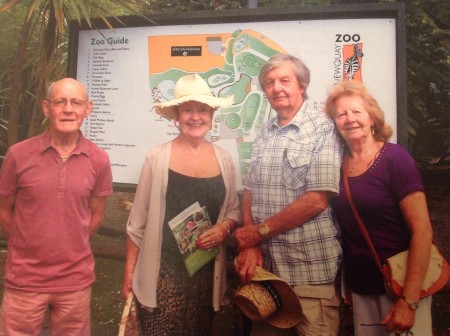
The Witney family visiting me at Newquay Zoo, full of a lifetime of stories of working with animals, 2014. (Derek Witney and his wife on the right) Image: Mark Norris
Derek told me more about his meeting with Peter, who is now suffering from health problems. Derek also remembers meeting Herbert Whitley wearing a battered pair of old white plimsolls at Paignton Zoo (Whitley was famous for his scruffy or eccentric dress sense). Derek’s other family memories of this period include:
“Eight or nine people in the shelter that night it was hit included my grandmother who was keeping house while we were on our way down to Paignton with a convoy of animals having left that morning.
The alarm was raised by two of the zoo staff who were in another part of the shelter.
I was not aware of any animals going to Whipsnade for the duration of the war but this could well be true.
What I am absolutely certain is that the Elephants remained at the park and worked in the circus during the whole of the war. I know this to be true as I looked after them as part of my duties in my school holidays.
Frank Foster came to Chessington at the start of the war from Bertram Mills Circus along with some of the animal trainers and remained there until the end of hostilities when he and some of the artists returned to the Bertram Mills circus while at Chessington Frank was responsible for the circus smooth running only.”
Derek Witney, personal comments, 2014
As we pored over past maps of Chessington Zoo in the past (http://www.chessingtonzoo.info/zoo-maps.html) to locate where the shelters were, Derek mentioned that the surviving brick built shelters remained for many years in various roles such as tool sheds, something Peter said they looked much like.
“I hope that this will further inform you of life at Chessington”: I am currently chatting to Derek Witney about more of his wartime memories of Paignton Zoo.
This temporary wartime expedient business merger between Goddard’s Chessington Zoo and Whitley’s Primley / Paignton Zoo is not a well-studied area and I will post more on this blog as I uncover more.
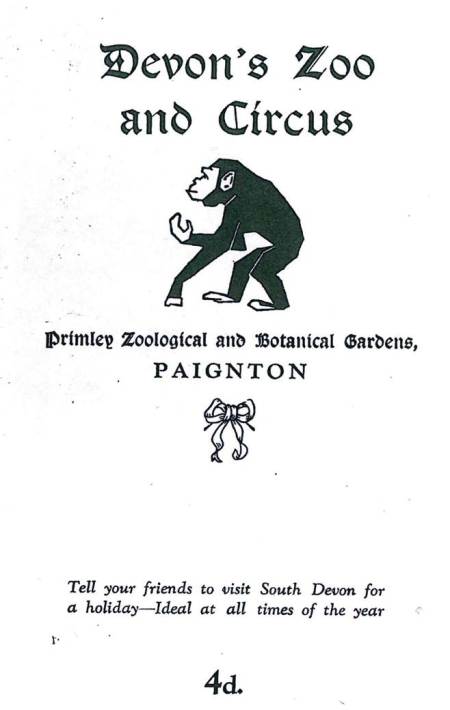
“You Will Enjoy Yourselves Here!” These documents remain in the Archive at Paignton Zoo and we will post further research about them in time.

Derek Witney, one of the remaining Chessington / Paignton Zoo wartime staff children, mentioned to people after my Kew Guild talk about the GIs at Paignton Zoo and their big Anti Aircraft AA guns, being there at Paignton Zoo protecting the Clennon Gorge GI camp in the run up to D-Day.
https://worldwarzoogardener1939.wordpress.com/2014/08/28/war-and-the-whitleys-para-medics-peacocks-and-paignton-zoo/
https://worldwarzoogardener1939.wordpress.com/2010/06/23/d-day-1944-and-the-disappearing-peacocks-and-ducks-of-wartime-paignton-zoo/
This was further supported by Dave Ellacott, Reserves Warden, Primley park and Clennon Gorge, who mentioned
“As for GI leftovers I have not found anything which would have hinted at their presence. Google earth makes a claim that there was a gun emplacement in Primley Park which makes sense as this is on an elevated position with good 360 views of Torbay.”
Lots more stories to follow …
Remembering Ronald and Annie Page and Elizabeth Arnold, “Died at Chessington Zoo Shelter”, 2 October 1940.
Research posted by Mark Norris at Newquay Zoo, World War Zoo Gardens Project.

































